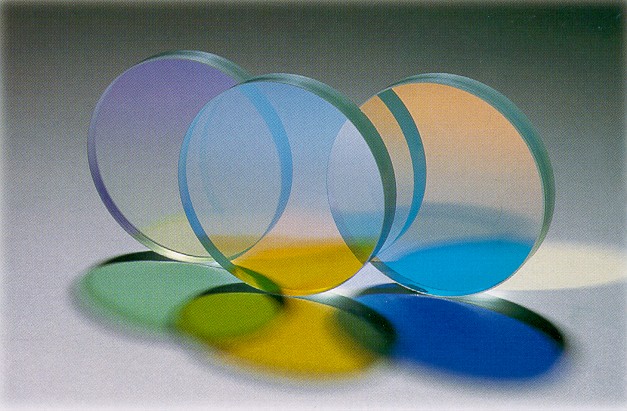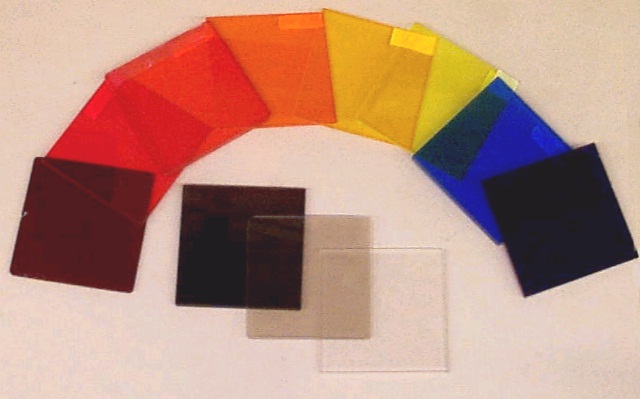|
Thin-film Optics
Thin-film optics is the branch of optics that deals with very thin structured layers of different materials. In order to exhibit thin-film optics, the thickness of the layers of material must be similar to the coherence length; for visible light it is most often observed between 200 and 1000 nm of thickness. Layers at this scale can have remarkable reflective properties due to light wave interference and the difference in refractive index between the layers, the air, and the substrate. These effects alter the way the optic reflects and transmits light. This effect, known as thin-film interference, is observable in soap bubbles and oil slicks. More general periodic structures, not limited to planar layers, exhibit structural coloration with more complex dependence on angle, and are known as photonic crystals. In manufacturing, thin film layers can be achieved through the deposition of one or more thin layers of material onto a substrate (usually glass). This is most ... [...More Info...] [...Related Items...] OR: [Wikipedia] [Google] [Baidu] |
Dichroic Filters
An interference filter, dichroic filter, or thin-film filter is an optical filter that reflects some wavelengths (colors) of light and transmits others, with almost no absorption for all wavelengths of interest. An interference filter may be high-pass, low-pass, bandpass, or band-rejection. They are used in scientific applications, as well as in architectural and theatrical lighting. An interference filter consists of multiple thin layers of dielectric material having different refractive indices. There may also be metallic layers. Interference filters are wavelength-selective by virtue of the interference effects that take place between the incident and reflected waves at the thin-film boundaries. The principle of operation is similar to a Fabry-Perot etalon. Dichroic mirrors and dichroic reflectors are the same type of device, but are characterized by the colors of light that they reflect, rather than the colors they pass. Dielectric mirrors operate on the same princ ... [...More Info...] [...Related Items...] OR: [Wikipedia] [Google] [Baidu] |
Glass
Glass is an amorphous (non-crystalline solid, non-crystalline) solid. Because it is often transparency and translucency, transparent and chemically inert, glass has found widespread practical, technological, and decorative use in window panes, tableware, and optics. Some common objects made of glass are named after the material, e.g., a Tumbler (glass), "glass" for drinking, "glasses" for vision correction, and a "magnifying glass". Glass is most often formed by rapid cooling (quenching) of the Melting, molten form. Some glasses such as volcanic glass are naturally occurring, and obsidian has been used to make arrowheads and knives since the Stone Age. Archaeological evidence suggests glassmaking dates back to at least 3600 BC in Mesopotamia, Ancient Egypt, Egypt, or Syria. The earliest known glass objects were beads, perhaps created accidentally during metalworking or the production of faience, which is a form of pottery using lead glazes. Due to its ease of formability int ... [...More Info...] [...Related Items...] OR: [Wikipedia] [Google] [Baidu] |
Graphium Sarpedon
''Graphium sarpedon'', the common bluebottle or blue triangle in Australia, is a species of Swallowtail butterfly, swallowtail butterfly that is found in East Asia, East, South Asia, South and Southeast Asia, as well as eastern Australia. There are approximately sixteen subspecies with differing geographical distributions. Description Upperside opaque black. Forewings and hindwings crossed from above the tornal area on the hindwing to near the apex of the forewing by a semi-hyaline broad pale blue medial band which is broadest in the middle, more or less greenish and macular anteriorly; the portion of the band that crosses interspaces 6, 7 and 8 on the hindwing white; beyond the band on the hindwing there is a sub-terminal line of blue slender lunules. Underside similar, ground colour dark brown. Hindwing: a short comparatively broad sub-basal band from costa to sub-costal vein, and the postdiscal area between the medial blue band and the sub-terminal lunules velvety black tr ... [...More Info...] [...Related Items...] OR: [Wikipedia] [Google] [Baidu] |
Aglais Io
''Aglais io'', the European peacock, or the peacock butterfly, is a colourful butterfly, found in Europe and temperate Asia as far east as Japan. The peacock butterfly is resident in much of its range, often wintering in buildings or trees. It therefore often appears quite early in spring. The peacock butterfly has figured in research in which the role of eyespots as an anti-predator mechanism has been investigated. The peacock is expanding its range and is not known to be threatened. Characteristics The butterfly has a wingspan of . The base colour of the wings is a rusty red, and at each wingtip it bears a distinctive, black, blue and yellow eyespot. The underside is a cryptically coloured dark brown or black. There are two subspecies: ''A. io caucasica'' ( Jachontov, 1912), found in Azerbaijan, and ''A. io geisha'' ( Stichel, 1908), found in Japan and the Russian Far East. File:Paon-du-jour MHNT CUT 2013 3 14 Cahors Dos.jpg, Dorsal side File:Paon-du-jour MHNT CUT 2013 3 14 ... [...More Info...] [...Related Items...] OR: [Wikipedia] [Google] [Baidu] |
Spatial Filter
A spatial filter is an optical device which uses the principles of Fourier optics to alter the structure of a beam of light or other electromagnetic radiation, typically coherent laser light. Spatial filtering is commonly used to "clean up" the output of lasers, removing aberrations in the beam due to imperfect, dirty, or damaged optics, or due to variations in the laser gain medium itself. This filtering can be applied to transmit a pure transverse mode from a multimode laser while blocking other modes emitted from the optical resonator. The term "filtering" indicates that the desirable structural features of the original source pass through the filter, while the undesirable features are blocked. An apparatus which follows the filter effectively sees a higher-quality but lower-powered image of the source, instead of the actual source directly. An example of the use of spatial filter can be seen in advanced setup of micro-Raman spectroscopy. In spatial filtering, a lens is us ... [...More Info...] [...Related Items...] OR: [Wikipedia] [Google] [Baidu] |
Mirror
A mirror, also known as a looking glass, is an object that Reflection (physics), reflects an image. Light that bounces off a mirror forms an image of whatever is in front of it, which is then focused through the lens of the eye or a camera. Mirrors reverse the direction of light at an angle equal to its incidence. This allows the viewer to see themselves or objects behind them, or even objects that are at an angle from them but out of their field of view, such as around a corner. Natural mirrors have existed since Prehistory, prehistoric times, such as the surface of water, but people have been manufacturing mirrors out of a variety of materials for thousands of years, like stone, metals, and glass. In modern mirrors, metals like silver or aluminium are often used due to their high reflectivity, applied as a thin coating on glass because of its naturally smooth and very Hardness (materials science), hard surface. A mirror is a Wave (physics), wave reflector. Light consists ... [...More Info...] [...Related Items...] OR: [Wikipedia] [Google] [Baidu] |
Filter (optics)
An optical filter is a device that selectively transmits light of different wavelengths, usually implemented as a glass plane or plastic device in the optical path, which are either dyed in the bulk or have interference coatings. The optical properties of filters are completely described by their frequency response, which specifies how the magnitude and phase of each frequency component of an incoming signal is modified by the filter. Filters mostly belong to one of two categories. The simplest, physically, is the absorptive filter; then there are interference or dichroic filters. Many optical filters are used for optical imaging and are manufactured to be transparent; some used for light sources can be translucent. Optical filters selectively transmit light in a particular range of wavelengths, that is, colours, while absorbing the remainder. They can usually pass long wavelengths only (longpass), short wavelengths only (shortpass), or a band of wavelengths, bloc ... [...More Info...] [...Related Items...] OR: [Wikipedia] [Google] [Baidu] |
Glasses
Glasses, also known as eyeglasses (American English), spectacles (Commonwealth English), or colloquially as specs, are vision eyewear with clear or tinted lenses mounted in a frame that holds them in front of a person's eyes, typically utilizing a bridge over the nose and hinged arms, known as temples or temple pieces, that rest over the ears for support. Glasses are typically used for vision correction, such as with reading glasses and glasses used for nearsightedness; however, without the specialized lenses, they are sometimes used for cosmetic purposes. Safety glasses are eye protection, a form of personal protective equipment ( PPE) that are worn by workers around their eyes for protection. Safety glasses act as a shield to protect the eyes from any type of foreign debris that may cause irritation or injury; these glasses may have protection on the sides of the eyes as well as in the lenses. Some types of safety glasses are used to protect against visible and n ... [...More Info...] [...Related Items...] OR: [Wikipedia] [Google] [Baidu] |
Anti-reflective Coating
An antireflective, antiglare or anti-reflection (AR) coating is a type of optical coating applied to the surface of lens (optics), lenses, other optical elements, and photovoltaic cells to reduce reflection (physics), reflection. In typical imaging systems, this improves the efficiency since less light is lost due to reflection. In complex systems such as cameras, binoculars, telescopes, and optical microscope, microscopes the reduction in reflections also improves the Contrast (vision), contrast of the image by elimination of stray light. This is especially important in planetary astronomy. In other applications, the primary benefit is the elimination of the reflection itself, such as a coating on glasses, eyeglass lenses that makes the eyes of the wearer more visible to others, or a coating to reduce the glint from a covert viewer's binoculars or telescopic sight. Many coatings consist of transparent thin-film optics, thin film structures with alternating layers of contrasting ... [...More Info...] [...Related Items...] OR: [Wikipedia] [Google] [Baidu] |
Low Emissivity
Low emissivity (low ''e'' or low thermal emissivity) refers to a surface condition that emits low levels of radiant thermal (heat) energy. All materials absorb, reflect, and emit radiant energy according to Planck's law but here, the primary concern is a special wavelength interval of radiant energy, namely thermal radiation of materials. In common use, especially building applications, the temperature range of approximately -40 to +80 degrees Celsius is the focus, but in aerospace and industrial process engineering, much broader ranges are of practical concern. Definition Emissivity is the value given to materials based on the ratio of heat emitted compared to a perfect black body, on a scale from zero to one. A black body would have an emissivity of 1 and a perfect reflector would have a value of 0. Kirchhoff's law of thermal radiation states that absorption equals emissivity opaque (εopaque) for every specific wavelength/frequency (materials often have quite different e ... [...More Info...] [...Related Items...] OR: [Wikipedia] [Google] [Baidu] |
Optical Coating
An optical coating is one or more thin-film optics, thin layers of material deposited on an optical component such as a lens (optics), lens, prism (optics), prism or mirror, which alters the way in which the optic reflection (physics), reflects and transmittance, transmits light. These coatings have become a key technology in the field of optics. One type of optical coating is an anti-reflective coating, which reduces unwanted reflections from surfaces, and is commonly used on glasses, spectacle and camera lenses. Another type is the high-reflector coating, which can be used to produce mirrors that reflect greater than 99.99% of the light that falls on them. More complex optical coatings exhibit high reflection over some range of wavelengths, and anti-reflection over another range, allowing the production of dichroism, dichroic dichroic filter, thin-film filters. Types of coating The simplest optical coatings are thin layers of metals, such as aluminium, which are deposited on g ... [...More Info...] [...Related Items...] OR: [Wikipedia] [Google] [Baidu] |
Chemical Vapor Deposition
Chemical vapor deposition (CVD) is a vacuum deposition method used to produce high-quality, and high-performance, solid materials. The process is often used in the semiconductor industry to produce thin films. In typical CVD, the wafer (electronics), wafer (substrate) is exposed to one or more Volatility (chemistry), volatile wikt:precursor, precursors, which chemical reaction, react and/or chemical decomposition, decompose on the substrate surface to produce the desired deposit. Frequently, volatile by-products are also produced, which are removed by gas flow through the reaction chamber. Microfabrication processes widely use CVD to deposit materials in various forms, including: Single crystal, monocrystalline, polycrystalline, amorphous, and Epitaxy, epitaxial. These materials include: silicon (Silicon dioxide, dioxide, silicon carbide, carbide, silicon nitride, nitride, silicon oxynitride, oxynitride), carbon (carbon (fiber), fiber, carbon nanofibers, nanofibers, carbon nanot ... [...More Info...] [...Related Items...] OR: [Wikipedia] [Google] [Baidu] |







